
97.9 The Hill and Chapelboro.com have partnered with NC State Extension Master Gardener℠ volunteers of Orange County for “Playing in the Dirt,” a monthly column providing information and inspiration to gardeners of all skill levels! Check back on Chapelboro each month for a new subject – from our gardens to yours!
By Diantha Pinner and Lynn Calder, Orange County Master Gardener℠ volunteers
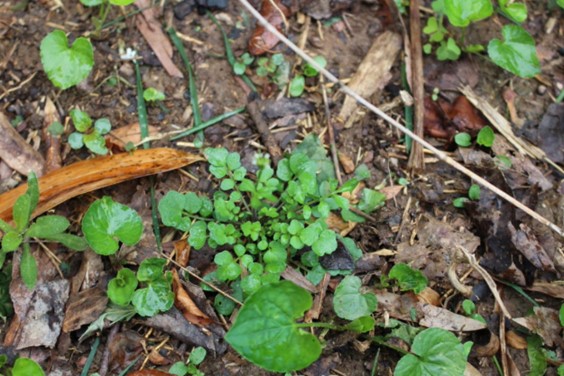
Hairy bittercress (Cardamine hirsute). Photo courtesy of NC Cooperative Extension, Forsyth County.
Although fall is known as the best time for planting, it’s important to take care of some tasks you might find less fun. Namely weeding. As Leslie Rose, Forsyth County Extension agent, advises in this article, if you take time now to clear out the seedlings of weeds that thrive in the winter, you’ll face less garden work in spring.
Weeds in the Piedmont that thrive in cooler temperatures and all through the winter have already germinated and are popping up as seedlings. If not removed during the fall and winter months, they will have taken over by spring. It’s easier to get them out now while you still want to be outside, the seedlings have fewer roots, and the ground is softer before our hard freezes.
To prevent the next crop, it’s important to remove the weeds before they flower and eliminate their ability to produce seeds. If weeding by hand or using a tool like a trowel or soil knife, be sure to remove the roots as well as the green foliage. If you are overwhelmed with the amount of weeds in your landscape and feel you must consider an herbicide, see the instructions in this article from Alexander County Extension.
Bees and other pollinators will be attracted to winter weeds once they begin flowering in spring. The flowers are one of their first food sources since early fall. At that point, you may want to let the weeds go in favor of feeding the pollinators. If you do want the weeds gone once they’re flowering, never spray the flowers with a poisonous herbicide; the chemicals can kill helpful insects. First mow or trim the weed flowers and wait a day or two to be sure pollinators are no longer visiting. Then carefully follow label instructions before applying any spray.
Common Fall Weed Seedlings
You may see these winter-thriving weeds in your Piedmont landscape:
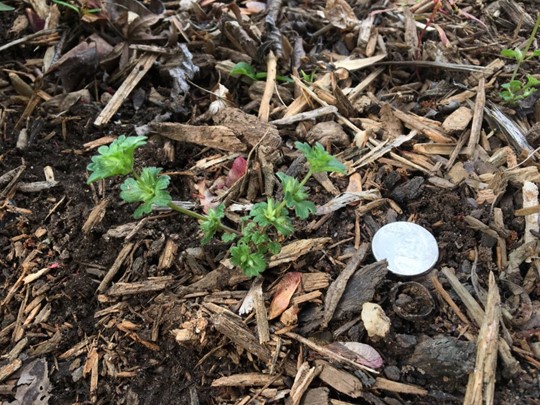
Henbit (Lamium amplexicaule). The leaves of henbit do not have petioles (the leaf stalk between the flat part of the leaf and the stem), the leaves attach directly to the stem. Both henbit and purple deadnettle have square stems. Photo and caption courtesy of NC Cooperative Extension, Forsyth County.
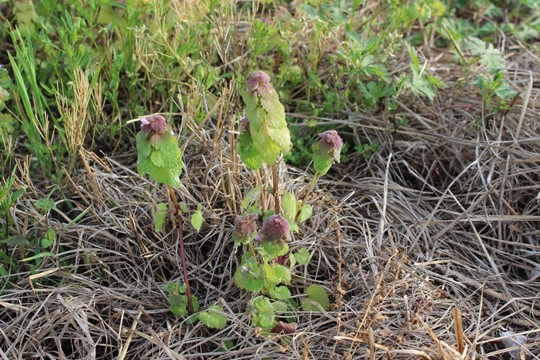
Purple deadnettle (Lamium purpureum). Note the square stems. Photo: Kira Sims CC0.
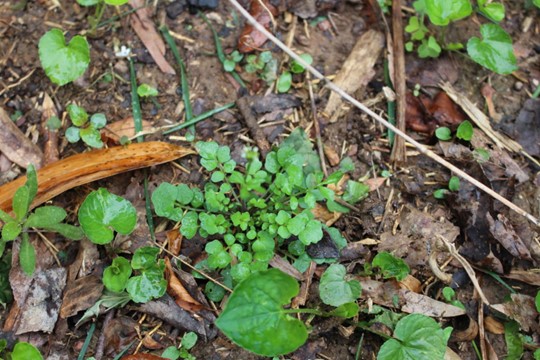
Hairy bittercress (Cardamine hirsute). Hairy bittercress, pictured in the center, grows as a rosette and its leaves have a distinctive shape. Try to catch this weed before it has seed capsules that can burst and spread in the garden. Photo and caption courtesy of NC Cooperative Extension, Forsyth County.

The small white flowers of hairy bittercress that develop into seed capsules. Photo and caption courtesy of NC Cooperative Extension, Forsyth County.
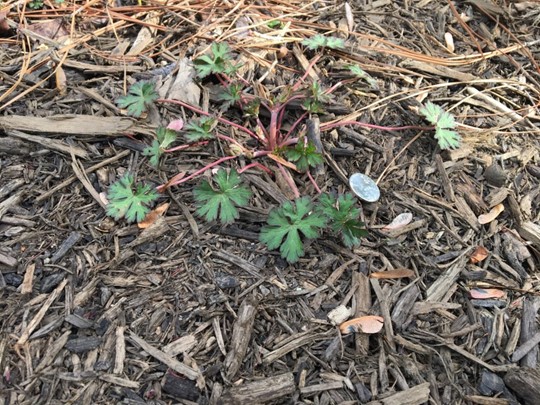
Carolina geranium (Geranium carolinianum). Carolina geranium has dissected leaves and a red color to the stem. Be sure to remove the taproot when pulling out this weed. Photo and caption courtesy of NC Cooperative Extension, Forsyth County.
Tips for Identifying and Controlling Other Weeds Year Round
The cooler weather of fall and winter may encourage you to tackle problem areas. Accurate identification is the key to good weed management any time of year. Knowing what type of weed you’re dealing with and how it grows and reproduces provide direction on how to eradicate or control it. This guide specifically about weeds in NC Piedmont landscapes will help you identify many of your undesirable plants and advise you about weed control techniques.
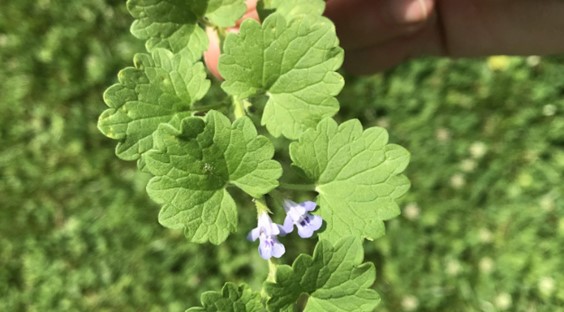
Flowering ground ivy or creeping Charlie (Glechoma hederacea). Photo by C. Carignan, University of Maryland Extension.
University of Maryland Extension also has published a good online resource with photos for identifying common weeds, understanding their characteristics, and managing them. Simply compare your weed to the photos, find a match, and then click on the photo to see information about how the weed grows and suggested ways to eliminate it.
Another good resource is the Virginia Tech Weed Identification online database. This resource enables you to select from an array of characteristics such as plant type, flower color, and leaf and stem shape. With each selection it narrows the list of possible matches.
Don’t forget that the Find a Plant feature of the NC State Extension Gardener Plant Toolbox can also help. After clicking Find a Plant, scroll to Whole Plant Traits, click on Plant Type and select Weed for profiles and photos of 265 weeds common to our area.
A number of mobile apps for identifying plants are available as well. This article by Erin Hill, Michigan State University Extension, reviews and ranks them according to accuracy and ease of use.
And, of course, you can bring samples to your Orange County Cooperative Extension office or email photos and ask the horticulture agent to identify the plant and advise you. Be sure your photos are clear, in focus, and show all parts of the plant.
For more information on identifying and managing weeds, see these articles:
-
- Don’t Forget to Pull the Weeds During Your Fall Garden Clean Up!Leslie Rose, NC Cooperative Extension, Forsyth County.
- Identifying and Managing Landscape Weeds (extensive guide with photos). Leslie Peck, NC State Extension and NC Cooperative Extension, Forsyth County.
- Managing Winter Weeds. Julie Campbell, NC Cooperative Extension, Alexander County. (All about herbicides)
More from the Master Gardener volunteers of Orange County:
-
- Dig Deeper: The Orange County Master Gardener volunteers are excited to partner with the Seymour Center in Chapel Hill for our fall Dig Deeper series on gardening topics. Please join us at 2551 Homestead Rd, Chapel Hill (map) for the following presentations:
- Ecological Gardening, Saturday, Nov. 9, 10:30–11:30 a.m.
- Winter Sowing, Thursday, Dec. 19, 10–11:30 a.m.
In spring 2025, Dig Deeper talks will be back at the Orange County Library in Hillsborough as well as the Seymour Center. Stay tuned for dates and topics!
-
- Have a plant or garden question? Email the Orange County Master Gardener volunteers at ocmgardeners@gmail.com or phone 919-245-2061.
- Subscribe to The Garden Buzz, the Orange County Master Gardeners’ monthlynewsletter, for gardening news and tips. And visit our website, The Orange Gardener, for helpful gardening information and tips.
- Follow us on Facebook! Our page is NC State Extension Master Gardener Volunteers, Orange County.
- Orange County Master Gardener volunteers have produced a 2025 Calendar – available now! (Cover design by Rebecca Margolese-Malin.)

image via Orange County Master Gardener Volunteers
The theme of the 2025 calendar is Ecological Gardening, designed to empower gardeners to create positive change in their environment. Each month provides information on a new topic, such as native plants, water management and gardening for birds and pollinators. You’ll find beautiful photos, gardening tips and tricks, and suggestions for ecologically friendly events and activities. This will be a great gift for friends and family! Proceeds of the calendar sales will support the community work of our Master Gardener volunteers.
Order your calendar: To order calendars with shipping included, click here. To order calendars for pickup at the Extension office in Hillsborough, click here (you’ll receive an email with pickup instructions).
Chapelboro.com does not charge subscription fees, and you can directly support our efforts in local journalism here. Want more of what you see on Chapelboro? Let us bring free local news and community information to you by signing up for our newsletter.


Comments on Chapelboro are moderated according to our Community Guidelines